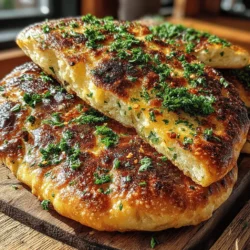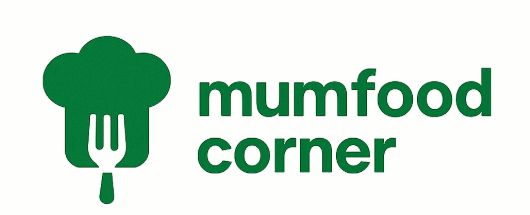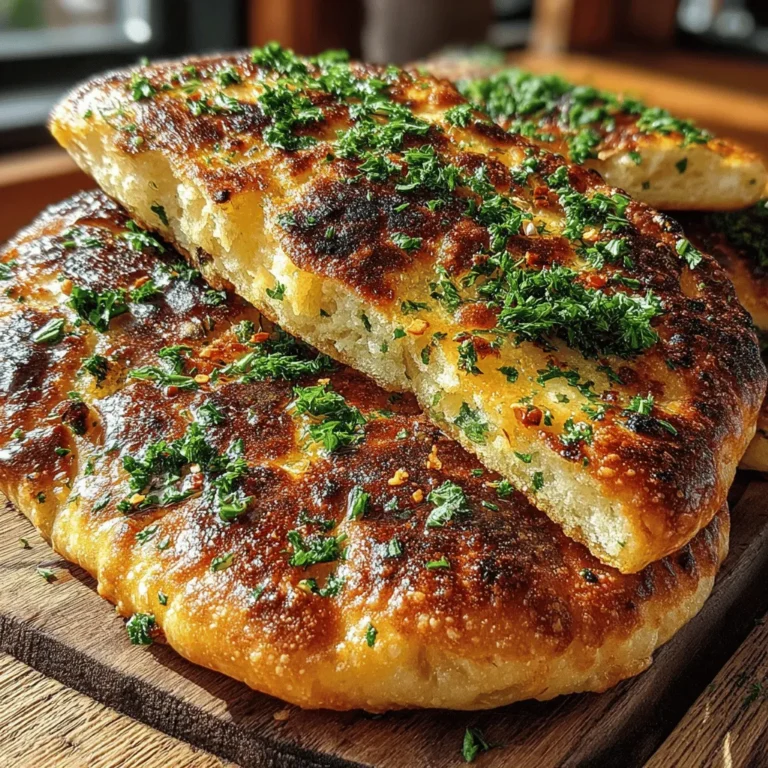Crispy Garlic Butter Flatbread Recipe
Flatbreads are a beloved staple in cuisines around the world, celebrated for their versatility and ability to complement a myriad of dishes. From the hearty naan of Indian cuisine to the delicate lavash of the Middle East, flatbreads serve not just as a side, but also as a canvas for a variety of toppings and spreads. They can be enjoyed warm from the oven, served alongside soups and stews, or stuffed with your favorite fillings. Among the many variations of flatbread, one recipe stands out for its simplicity and flavor: Crispy Garlic Butter Flatbread.
This Crispy Garlic Butter Flatbread is a delightful addition to any meal. It is incredibly easy to prepare, requiring minimal ingredients and tools, making it perfect for both novice cooks and seasoned chefs alike. With a quick cooking time, this recipe allows you to whip up a batch of warm, aromatic flatbreads in no time. The combination of garlic and butter infuses the bread with a rich flavor that will elevate any dish. Whether served as an appetizer, side dish, or even as a base for a creative pizza, this flatbread is sure to impress.
Understanding Flatbreads
Flatbreads, as the name suggests, are unleavened breads that are typically rolled out into flat shapes before cooking. They hold cultural significance in many regions, often serving as a staple food that has been passed down through generations. In addition to their historical roots, flatbreads are highly adaptable, varying in thickness, texture, and toppings based on regional preferences.
Common types of flatbreads include tortillas from Mexico, focaccia from Italy, and pita from the Middle East. Each of these variations brings its unique flair to the table, showcasing the incredible diversity of flatbreads across different cultures. Nutritionally, flatbreads can be a great addition to your diet. They are often lower in calories than traditional bread and can be made with whole grains, providing a good source of fiber and essential nutrients.
Ingredients Breakdown
The key to perfecting your Crispy Garlic Butter Flatbread lies in the quality and balance of your ingredients. Below is a detailed description of the components that make up this delicious recipe:
1. All-Purpose Flour: This is the foundation of your flatbread. All-purpose flour provides the necessary structure and texture, allowing the bread to rise slightly while still remaining flat. For a healthier twist, you can consider using whole wheat flour or a gluten-free blend, though adjustments may be needed for the dough’s consistency.
2. Baking Powder: Unlike yeast-based breads, which require time to rise, this recipe uses baking powder as a leavening agent. Baking powder helps the flatbread achieve a light and airy texture while still being quick to prepare.
3. Salt: Essential for enhancing the flavor of the flatbread, salt also helps to strengthen the dough, contributing to its overall texture.
4. Sugar: Just a touch of sugar balances the flavors and aids in browning the flatbread during cooking, resulting in a delightful golden crust.
5. Warm Water: The temperature of the water is crucial for activating the baking powder and creating a pliable dough. Warm water helps to dissolve the ingredients and ensures an even consistency.
6. Olive Oil: Adding olive oil not only enriches the flavor but also contributes to the tenderness of the flatbread. It helps prevent the dough from becoming too dry and adds a subtle richness.
7. Garlic and Butter: The stars of this recipe, garlic and butter, work together to create a savory and aromatic flavor profile. When brushed onto the flatbread after cooking, they offer a deliciously rich taste that is hard to resist. For those who enjoy a bit of spice, optional chili flakes can be added to the garlic butter mixture for an extra kick.
8. Fresh Parsley: As a garnish, fresh parsley not only adds a pop of color but also enhances the overall flavor. Its bright, herbal notes complement the richness of the garlic butter beautifully.
Step-by-Step Instructions
Now that you have a clear understanding of the ingredients, let’s dive into the step-by-step process of making your Crispy Garlic Butter Flatbread.
Preparing the Dough
To start, in a large mixing bowl, combine the all-purpose flour, baking powder, salt, and sugar. Whisk these dry ingredients together until they are well incorporated. This ensures that the baking powder is evenly distributed throughout the flour, which is crucial for achieving consistent rise and texture in your flatbreads.
Next, make a well in the center of the dry ingredients and add the warm water and olive oil. The warm water should not be too hot, as it can kill the leavening action of the baking powder. Mix the ingredients together with a spoon or your hands until a shaggy dough begins to form. The dough should be soft but not sticky; if it feels too sticky, you can sprinkle in a little more flour as needed.
Kneading the Dough
Once the dough has come together, transfer it to a lightly floured surface. Begin kneading the dough by pressing it down with the heel of your hand, folding it over, and repeating the process. Kneading is essential for developing gluten, which gives the flatbread its desired elasticity and chewiness. Knead the dough for about 5-7 minutes, or until it is smooth and elastic.
Tips for Achieving the Right Texture and Elasticity
– Don’t Overwork the Dough: While kneading is important, be careful not to overdo it. Over-kneading can lead to tough bread rather than tender flatbreads.
– Check for Pliability: The dough should spring back slightly when you poke it with your finger. If it feels too dry, add a few drops of water; if it’s too wet, sprinkle in a bit more flour.
Resting the Dough
After kneading, form the dough into a ball and place it in a lightly oiled bowl, covering it with a damp cloth or plastic wrap. Allow the dough to rest for about 15-30 minutes. This resting period is crucial as it relaxes the gluten, making it easier to roll out later. During this time, you can prepare the garlic butter mixture by melting butter in a small saucepan and adding minced garlic (and chili flakes, if desired). This will allow the flavors to meld, ensuring a deliciously fragrant topping for your flatbread once it’s cooked.
Stay tuned for the next part, where we will guide you through the cooking process, including tips for achieving that perfect crispy texture and additional serving suggestions for your Crispy Garlic Butter Flatbread.
{{image_2}}
Explanation of Gluten Relaxation and Its Impact on Dough Handling
When making flatbread, understanding gluten relaxation is essential for achieving the perfect texture. Gluten, a protein found in wheat flour, is responsible for the dough’s elasticity and strength. During the mixing process, gluten strands form a network that gives the dough its structure. However, if you don’t allow the dough to relax after kneading, it can become tough and difficult to roll out.
Gluten relaxation occurs when the dough is allowed to rest after mixing. This resting period helps the gluten strands to unwind and settle. As a result, the dough becomes more pliable, making it easier to shape without tearing. A general rule of thumb is to let your dough rest for at least 30 minutes, covered with a damp cloth or plastic wrap to prevent it from drying out. This simple step will make a significant difference in handling and rolling out your flatbreads, ensuring they turn out tender and crispy.
Crafting the Garlic Butter Mixture
Ingredients and Proportions for the Garlic Butter
To create the perfect garlic butter mixture for your flatbread, you’ll need the following ingredients:
– 1/2 cup unsalted butter (1 stick), melted
– 4 cloves of garlic, finely minced
– 1 tablespoon fresh parsley, chopped (optional for garnish)
– 1/2 teaspoon salt
– 1/4 teaspoon black pepper
– 1/4 teaspoon red pepper flakes (optional for added heat)
These ingredients work together to provide a rich, aromatic flavor that enhances the overall taste of your flatbreads. The melted butter serves as a flavorful base, while the garlic adds depth and a savory kick.
Techniques for Blending Flavors Effectively
To prepare the garlic butter, combine the melted butter, minced garlic, salt, black pepper, and red pepper flakes (if using) in a small bowl. Mix thoroughly until all ingredients are well incorporated. For enhanced flavor, consider allowing the mixture to sit for about 10-15 minutes before using it. This resting time allows the garlic to infuse its flavor into the butter, creating an even more pronounced garlic taste in your flatbread.
The Role of Garlic in Enhancing the Overall Taste of Flatbread
Garlic is a powerful flavor enhancer that can elevate simple dishes to new culinary heights. In this recipe, garlic not only adds a delightful aroma but also complements the richness of the butter and the dough’s taste. Additionally, garlic has been known to provide health benefits, such as boosting the immune system and possessing anti-inflammatory properties, making your flatbread not just delicious but also nutritious.
Rolling and Cooking the Flatbreads
Techniques for Rolling Out the Dough Evenly
Once your dough has rested and your garlic butter is ready, it’s time to roll out the flatbreads. Start by dividing the dough into equal portions, typically about 4-6 pieces, depending on your desired flatbread size. Lightly flour your work surface and a rolling pin to prevent sticking.
Begin by flattening each portion into a disc shape using your hands. Then, gently roll the dough outwards from the center, applying even pressure to maintain a uniform thickness. Aim for about 1/4 inch thick for optimal crispiness. If the dough resists rolling or springs back, give it a few more minutes to rest. This will help the gluten relax further, making it easier to roll.
Importance of Cooking Temperature and Timing for Achieving Crispiness
For the best results, preheat your skillet or griddle over medium-high heat. A hot cooking surface is crucial for achieving that desired crispy texture. You can test the heat by sprinkling a few drops of water onto the skillet; if they dance and evaporate quickly, the pan is ready.
Once heated, place your rolled-out flatbread on the skillet. Cook for about 2-3 minutes on one side until bubbles form and the underside is golden brown. Flip the flatbread using a spatula and cook for an additional 1-2 minutes. Adjust the heat as necessary; if the flatbreads are browning too quickly, reduce the heat slightly.
Instructions on Flipping and Applying the Garlic Butter Mixture for Maximum Flavor Infusion
As soon as you flip the flatbread, use a brush or spoon to generously apply the garlic butter mixture on the cooked side while it’s still hot. This allows the butter to melt into the dough, infusing each bite with flavor. After about 30 seconds, flip the bread again to cook the second side for a brief moment, ensuring the garlic butter is well distributed and slightly crisped.
Repeat this process for all portions of dough, stacking the finished flatbreads on a plate or in a warm oven while you continue cooking the rest.
Serving Suggestions
Ideas for Garnishing Flatbreads with Parsley and Chili Flakes
To add an extra touch to your crispy garlic butter flatbreads, consider garnishing them with chopped parsley and a sprinkle of chili flakes. The fresh parsley provides a pop of color and a hint of freshness, while the chili flakes add an appealing heat. These finishing touches not only enhance the visual appeal but also elevate the flavor profile, making the flatbreads more enticing.
Suggestions for Pairing Flatbreads with Dips, Soups, or Main Dishes
Crispy garlic butter flatbreads are incredibly versatile and can be paired with various dishes. Consider serving them alongside:
– Hummus or tzatziki for a refreshing dip
– Tomato soup or roasted red pepper soup for a cozy meal
– Grilled meats or vegetables for a heartier option
These pairings complement the rich garlic flavor of the flatbreads while providing a balanced meal.
Presentation Tips for Serving Flatbreads at Gatherings or Family Meals
When serving your flatbreads, presentation can make a significant impact. Arrange the flatbreads on a large platter, overlapping them slightly for a rustic look. For added flair, place small bowls of dips around the flatbreads and garnish with fresh herbs. If you’re serving them at a gathering, consider cutting the flatbreads into triangles or strips for easy sharing.
Health Benefits of Homemade Flatbread
Comparison of Homemade Flatbread to Store-Bought Options
Making flatbread at home is not only simple but also healthier than buying pre-packaged options. Store-bought flatbreads often contain preservatives, stabilizers, and unhealthy additives that can detract from the quality of the final product. In contrast, when you make flatbread at home, you control the ingredients, ensuring they are fresh and free from harmful additives.
Nutritional Advantages of Using Fresh Ingredients
Homemade flatbreads allow you to select high-quality ingredients, such as whole-grain flour, which is rich in fiber and nutrients. Using fresh herbs, like parsley, and avoiding excess salt and unhealthy fats can create a more nutritious alternative to store-bought bread. The ability to customize ingredients also means you can cater to specific dietary needs, such as gluten-free or vegan options, enhancing the health benefits even further.
Potential for Customization with Whole Grains or Herbs
One of the best aspects of making your flatbread is the freedom to experiment with flavors and textures. You can substitute all-purpose flour with whole wheat flour or a gluten-free blend to boost the nutritional profile. Additionally, incorporating herbs into the dough, such as rosemary or thyme, can add a delightful fragrance and flavor to your flatbreads, making them uniquely yours.
Conclusion
In summary, crispy garlic butter flatbread is not only a delightful addition to any meal but also an easy recipe to master in your own kitchen. The combination of a well-prepared dough, a rich garlic butter mixture, and the right cooking techniques results in a flatbread that is crispy on the outside and tender on the inside.
We encourage you to try making flatbread at home; the experience is both rewarding and delicious. Don’t hesitate to explore variations of this recipe to suit your personal tastes or dietary needs—whether it’s adding different herbs, spices, or even cheese. With each attempt, you’ll refine your technique and discover new flavors, making homemade flatbread a staple in your culinary repertoire. Enjoy the process and savor the results!


